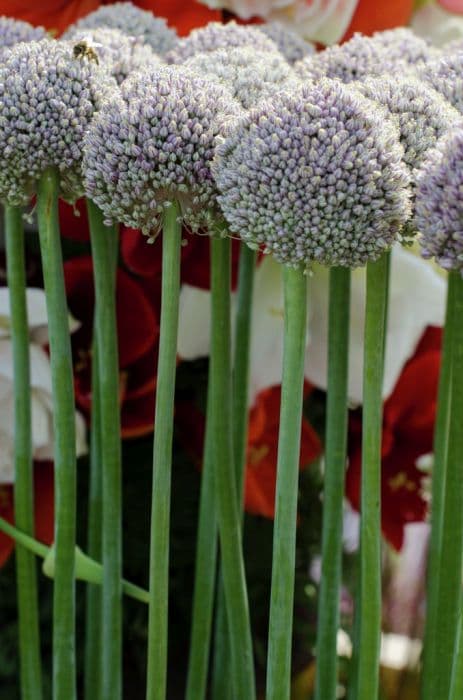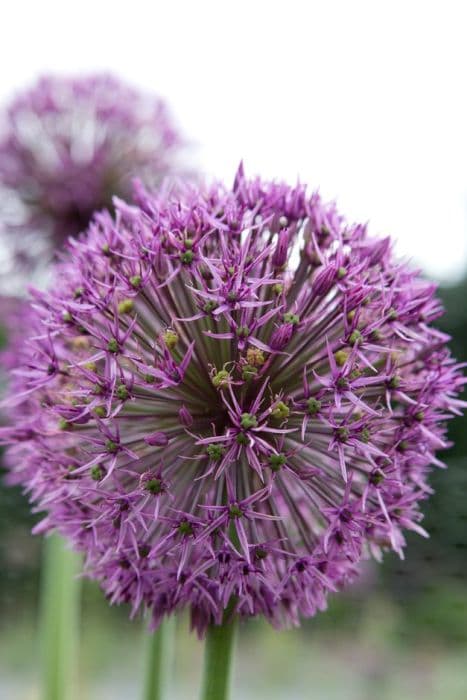Wild garlic Allium ursinum

ABOUT
Allium ursinum, commonly known as wild garlic, is a plant recognized for its distinctive features. The plant grows with a single, straight stem that's both smooth and cylindrical. At the base of this stem, there are several broad, elongated leaves of a deep green color that emerge from the soil. These leaves are shaped like an elongated oval, somewhat resembling a lance, and have soft, hairy undersides. The leaves of wild garlic exude a strong garlic scent when crushed, a characteristic that is a hallmark of the plant. During its flowering period, wild garlic exhibits a small, globe-shaped cluster of star-like flowers. These delicate blooms are usually white, and they sit atop the stem forming an umbrella-like shape known as an inflorescence. The overall structure of wild garlic is simple and elegant, with a gentle grace that belies its robust, pungent nature. Despite its unassuming appearance, the plant is a resilient perennial that's capable of carpeting the forest floor where it grows, creating swathes of green and white. The entire plant, from the bulb to the flowers, carries the familiar garlic aroma, which makes it quite distinctive even for those encountering it for the first time.
About this plant
 Names
NamesFamily
Amaryllidaceae.
Synonyms
Ramsons, Wild Garlic, Bear's Garlic, Buckrams, Broad-leaved Garlic, Wood Garlic, Bear Leek.
Common names
Allium ucrainicum, Allium ursinum var. ucrainicum, Cepa ursina.
 Toxicity
ToxicityTo humans
Wild garlic, also known as Allium ursinum, is generally not considered toxic to humans and is in fact edible. Wild garlic is commonly used as a food ingredient for its garlic-like flavor. However, it's important not to confuse wild garlic with other similar-looking plants such as lily of the valley or autumn crocus, which are toxic. Consuming those plants by mistake can lead to poisoning with symptoms that might include nausea, vomiting, abdominal pain, and in severe cases, irregular heartbeats and seizures.
To pets
Wild garlic, or Allium ursinum, can be toxic to pets, especially cats and dogs. While it is less toxic than commercial garlic, ingestion can still lead to symptoms of toxicity due to the presence of compounds that can cause damage to red blood cells, potentially leading to hemolytic anemia. Symptoms of poisoning may include lethargy, abdominal pain, vomiting, diarrhea, and in severe cases, symptoms related to anemia like pale gums, rapid breathing, and ataxia. It's important to prevent pets from ingesting wild garlic and seek veterinary care if poisoning is suspected.
 Characteristics
CharacteristicsLife cycle
Perennials
Foliage type
Deciduous
Color of leaves
Green
Flower color
White
Height
1 feet 2 inches [30-45 cm]
Spread
1 feet [30 cm]
Plant type
Bulb
Hardiness zones
5
Native area
Europe
Benefits
 General Benefits
General Benefits- Culinary uses - Allium ursinum, commonly known as wild garlic, is a versatile herb that adds a unique, mild garlic flavor to dishes.
- Nutritious - It is a good source of vitamins A and C, as well as minerals like iron and magnesium.
- Pollinator attraction - Wild garlic flowers are attractive to bees and other pollinators, which is beneficial for supporting local ecosystems.
- Low maintenance - As a wild plant, it is relatively hardy and can grow well in shaded areas with minimal care.
- Edible landscaping - Wild garlic can be a visually appealing addition to gardens and also serves a dual purpose as a culinary herb.
- Soil improvement - It has the potential to improve soil quality over time through its natural life cycle and decay of plant matter.
- Companion planting - It can be used in companion planting to improve the health and flavor of other plants in the garden.
 Medical Properties
Medical Properties- Antibacterial: Allium ursinum, commonly known as wild garlic, exhibits antibacterial properties against various bacteria, including those resistant to antibiotics.
- Antioxidant: It contains compounds that act as antioxidants, potentially neutralizing harmful free radicals in the body.
- Cardiovascular health: Wild garlic may contribute to cardiovascular health by helping to lower blood pressure and cholesterol levels.
- Digestive aid: The plant is traditionally used to stimulate digestion and address intestinal disorders.
- Antifungal: It has shown antifungal activities, useful in combating fungal infections.
- Anti-inflammatory: The plant contains compounds that may reduce inflammation, which is beneficial in conditions such as arthritis.
 Air-purifying Qualities
Air-purifying QualitiesThis plant is not specifically known for air purifying qualities.
 Other Uses
Other Uses- Allium ursinum, commonly known as 'wild garlic', can be used to create a natural green dye for textiles, leveraging its rich green leaves to impart color.
- The leaves of wild garlic can be macerated into a paste and used as an insect repellent, especially for warding off aphids in gardens.
- Wild garlic can be fermented into a tangy, garlic-flavored sauerkraut alternative, adding a unique twist to traditional fermented dishes.
- Due to its strong aroma, wild garlic can be incorporated into homemade cleaning products to add a fresh scent and slight antibacterial properties.
- As a companion plant, wild garlic can be grown in the garden to mask the scent of more vulnerable plants, potentially deterring pests such as deer and rabbits.
- The leaves of wild garlic can be used to wrap and flavor other foods during cooking, similar to grape leaves in Mediterranean cuisine.
- Wild garlic flowers are edible and can be used as a decorative, flavorful garnish on salads, soups, and other dishes.
- Crushed leaves of wild garlic can be rubbed on wooden cutting boards to naturally disinfect and impart a subtle garlic scent.
- Fresh wild garlic leaves can be laid under fruit trees as a natural mulch, slowly releasing nutrients as they decompose.
- Wild garlic seeds can be used in bird feeders, giving wild birds a change of diet and benefiting from the seeds' high nutritional content.
Interesting Facts
 Feng Shui
Feng ShuiThe plant Wild Garlic is not used in Feng Shui practice.
 Zodiac Sign Compitability
Zodiac Sign CompitabilityThe plant Wild Garlic is not used in astrology practice.
 Plant Symbolism
Plant Symbolism- Purity: Allium ursinum, commonly known as wild garlic, is often associated with purity due to its bright white flowers and its natural ability to deter pests.
- Protection: Wild garlic has a strong odor which is believed to ward off negative influences and provide protection, much like its cultivated relative garlic.
- Health: Historically, wild garlic has been used for its medicinal properties, symbolizing good health and well-being.
- Renaissance: The emergence of wild garlic in spring connects it with renewal, rebirth, and the beginning of a new cycle.
 Water
WaterWild garlic, or Allium ursinum, thrives when watered deeply once a week, receiving about 1 inch or 0.6 gallons of water per square foot. It's important to adjust this schedule during periods of heavy rainfall or drought to mimic its natural woodland environment. In dry spells, water twice a week to maintain consistent soil moisture. For best results, water the plant at soil level to avoid wetting the foliage, which can lead to fungal diseases. Always allow the top inch of soil to dry out between waterings to prevent overwatering, which could cause root rot.
 Light
LightWild garlic prefers dappled sunlight or part shade, similar to its natural woodland habitat. Plant it in a spot where it receives morning sun and is protected from the harsh afternoon rays. Observe the plant's response to your specific lighting conditions and adjust its location if necessary to ensure it receives the ideal amount of light without getting scorched.
 Temperature
TemperatureWild garlic is cold-hardy and can withstand temperatures as low as 20°F, although it thrives in temperatures between 50°F and 75°F. It will go dormant in summer if exposed to temperatures over 80°F, so it's best to plant it in a spot that stays within this temperature range. Protect the plant from extreme heat to avoid stress.
 Pruning
PruningWild garlic does not require extensive pruning, but removing spent flower heads can promote more vigorous foliage growth. Prune the faded flower stems after blooming, typically in late spring or early summer. You do not need to prune the foliage unless you wish to harvest some leaves for culinary use, in which case do so sparingly.
 Cleaning
CleaningNot needed
 Soil
SoilWild garlic (Allium ursinum) thrives in moist, well-draining soil rich in organic matter with a pH range of 6.5 to 7.5. A peat-based soil mix amended with compost and a little sand for drainage makes an ideal soil mix for wild garlic.
 Repotting
RepottingWild garlic, commonly known as ramsons, typically does not need frequent repotting and can be repotted every 2-3 years or when the clumps become overcrowded in their current container.
 Humidity & Misting
Humidity & MistingRamsons prefer high humidity levels, ideally around 50% or higher, which mimics their native woodland habitat conditions.
 Suitable locations
Suitable locationsIndoor
Place ramsons in well-lit area, ensure moist, rich soil.
Outdoor
Plant ramsons in shade, keep soil consistently moist.
Hardiness zone
5-8 USDA
 Life cycle
Life cycleAllium ursinum, commonly known as wild garlic or ramsons, starts its life cycle when a seed germinates in well-draining soil, typically germinating in the autumn and overwintering in a dormant state. In early spring, ramsons resume growth, developing into a bulb which produces slender, green leaves. From April to June, when conditions are optimal with adequate moisture and partial shade, the ramsons enter the flowering stage, displaying white, star-like flowers arranged in an umbel atop a leafless stalk. Following pollination, which is often facilitated by bees and other insects attracted to the nectar and pollen, the flowers develop into three-lobed seed capsules. Once the seeds mature, they are released from the capsule and dispersed by wind, water, or animal movement, ready to start the next generation. After seed dispersal, the plant's foliage dies back, and the bulb enters a period of dormancy until the next growing season.
 Propogation
PropogationPropogation time
Spring
Allium ursinum, commonly known as wild garlic or ramsons, is a perennial plant that can be propagated by seed or vegetatively through bulb division. The most popular method of propagation is through bulb division, which is typically done in late summer after the leaves have died back or in early autumn. To propagate ramsons via bulb division, gently lift the clump of bulbs from the soil with a garden fork. Carefully separate the bulbs, ensuring that each division has at least one growth point. Replant the bulbs at a depth of approximately 2 inches (5 centimeters), spacing them about 4 inches (10 centimeters) apart to allow room for growth. Water the newly planted bulbs well to help establish them. This vegetative method is faster and more reliable than growing from seed, ensuring that the new plants are genetically identical to the parent plant.









